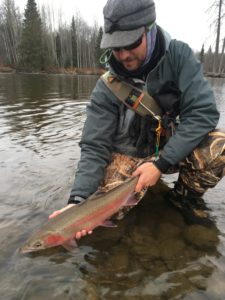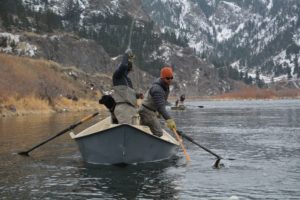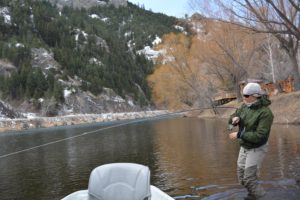 It appears that Fall is finally upon us, and with that, it means sometimes winter like weather. For most of us that live on the water, we love this time of year because of a couple reasons; less people on the river and some really really great fishing! But how do you make it more enjoyable if you do indeed hit the river on these cooler and often wetter conditions. Here are some suggestions on what I do to keep warm and dry during this time of year.
It appears that Fall is finally upon us, and with that, it means sometimes winter like weather. For most of us that live on the water, we love this time of year because of a couple reasons; less people on the river and some really really great fishing! But how do you make it more enjoyable if you do indeed hit the river on these cooler and often wetter conditions. Here are some suggestions on what I do to keep warm and dry during this time of year.
One of the most important things to remember and follow is absolutely NO COTTON!!! As in zero, none, notta…. In the outdoor world, cotton can kill you by increasing your risk of hypothermia during the cooler wetter months. So again, NO COTTON!!!
A layering system is going to be your best friend at keeping your core warm while you’re on the water. Start off with a good base layer that is designed to pull moisture away from your body. There are a number of good brands out there, like most gear, buy the best that you can afford, because when it comes to outdoor gear, you get what you pay for.  If the base layer has a merino wool blend, you’ll be doing yourself a favor. Depending on the actual temp outside and the amount of activity you’ll be doing, the rest of the layers will vary. If it is below freezing outside and I know I’ll be in the boat all day, my next layer is a thinner fleece layer. I wear this layer because it compliments the base layer nicely, and adds additional warmth at a low weight ratio. My next two layers are fleece wading pants. The first pair is a lighter weight pair that makes up layer three on my legs. The second pair is a heavier weight pair that makes up the final insulating layer for the lower half of my body. As for my feet, I actually just wear one pair of wool socks. I’ll get into the reason why I only wear one pair a little bit later.
If the base layer has a merino wool blend, you’ll be doing yourself a favor. Depending on the actual temp outside and the amount of activity you’ll be doing, the rest of the layers will vary. If it is below freezing outside and I know I’ll be in the boat all day, my next layer is a thinner fleece layer. I wear this layer because it compliments the base layer nicely, and adds additional warmth at a low weight ratio. My next two layers are fleece wading pants. The first pair is a lighter weight pair that makes up layer three on my legs. The second pair is a heavier weight pair that makes up the final insulating layer for the lower half of my body. As for my feet, I actually just wear one pair of wool socks. I’ll get into the reason why I only wear one pair a little bit later.
For my upper body, I start off with the same sort of base layer that my lower half has on it. I then add a comparable lighter weight fleece layer like what is on my lower half. My next layer will be a slightly heavier weight fleece or wool layer, or possibly a vest of some sort. The important thing for these first few layers is to concentrate on what will keep your core warm. These layers will most likely stay on you for the duration of your outdoor activity. The next few layers may be taken off and put back on multiple times so that you can maintain your desired body temperature. It’s important not to get too hot or too cold. If you get too hot, you’ll sweat, and that sweat will cool down making you feel cold. If you get too cold, it could take awhile to warm back up once you add your other layers. So regulating your body heat properly is key to being able to endure the cold temperatures you’re fishing in. The next layer I put on is a slightly heavier weight fleece sweater or jacket, preferably a jacket, so that I can take it off easy if need be. The final insulating layer for the upper half of my body, is a puffy jacket. I could go on and on about how great a puffy jacket is, but for now, I’ll just write this; if you fish or hunt or just enjoy the outdoors in general and you do not have a puffy jacket, then you are wrong. Puffy jackets are absolutely amazing!
 The shell of the layering system is going to be your waders for your lower half and your rain jacket for your upper half. I’ve spent many years fishing or hunting in the cold, last year I was introduced to the Orvis SonicSeam Waterfowler BootFoot Wader, and I can honestly say this is the first pair of bootfoot waders that actually keep my feet warm. I have had many bootfoot waders over the years with however many grams of thinsulate in them, those waders never truly kept my feet warm after being out in the elements for an extended period of time. The Orvis Waterfowler has an actual felt liner that is removable in the bootfoot, this wader is a total game changer for the cold weather angler. The wader itself is made of breathable material, so the additional layers in my layering system are needed to maintain my core body temperature. Your rain jacket should be the best one you can afford. Don’t skimp on this piece of equipment. You may hardly use your rain jacket, but for those moments that you do have to, a good rain jacket will keep out the elements while at the same time it is breathable, making life in the shell very enjoyable. A bad or cheap rain jacket probably won’t breathe well and probably isn’t that waterproof, this will create a miserable and dangerous condition out on the water.
The shell of the layering system is going to be your waders for your lower half and your rain jacket for your upper half. I’ve spent many years fishing or hunting in the cold, last year I was introduced to the Orvis SonicSeam Waterfowler BootFoot Wader, and I can honestly say this is the first pair of bootfoot waders that actually keep my feet warm. I have had many bootfoot waders over the years with however many grams of thinsulate in them, those waders never truly kept my feet warm after being out in the elements for an extended period of time. The Orvis Waterfowler has an actual felt liner that is removable in the bootfoot, this wader is a total game changer for the cold weather angler. The wader itself is made of breathable material, so the additional layers in my layering system are needed to maintain my core body temperature. Your rain jacket should be the best one you can afford. Don’t skimp on this piece of equipment. You may hardly use your rain jacket, but for those moments that you do have to, a good rain jacket will keep out the elements while at the same time it is breathable, making life in the shell very enjoyable. A bad or cheap rain jacket probably won’t breathe well and probably isn’t that waterproof, this will create a miserable and dangerous condition out on the water.
 I mentioned earlier that I only wear one pair of wool socks and it’s only one pair of wool hikers grade socks at that. The felt liner in my waders allows me to do so, they are that warm, just something to consider if you’re getting cold feet out there.
I mentioned earlier that I only wear one pair of wool socks and it’s only one pair of wool hikers grade socks at that. The felt liner in my waders allows me to do so, they are that warm, just something to consider if you’re getting cold feet out there.
In addition to your insulation layers and your shell, you’ll have to bring along items to keep your head and neck warm, as well as your fingers. Warm hats, wool and polar buffs, and cut-off gloves with mittens built in can do the trick. One thing I do to help my hands stay warm, is to bring multiple pairs of gloves/mittens. That way, if one pair gets really wet, I move on to the next pair. I also keep a pretty good supply of those disposable hand warmers in my boat bag. Having those in your pocket can help heat those fingers back up if the elements have numbed them up.
When it comes to food and drinks on the colder days, bring hot foods like soup or chili, and hot drinks like coffee or warm tea or even warm apple cider. By pumping in warm foods and hot drinks, it helps warm up your insides and provides much needed fuel to keep that interior furnace running on those cold days.
With a proper layering system, an outstanding shell, warm items for your extremities, and warm foods/drinks to consume; you’ll find that you can not only last a lot longer in the more extreme elements, but you’ll actually enjoy your time out there more.
Here is a list of Ben’s layering/shell system for your reference:
Base Layer-Sitka Core Bottoms and Top.
Insulation Layer One-Sitka Traverse Bottoms and Hoody Top.
Insulation Layer Two-Lightweight Wader Pant and Sitka Jetstream Vest.
Insulation Layer Three-Redington Wader Pant and Sitka 90% Jacket.
Insulation Layer Four (Upper Body)-Sitka Kelvin Lite Jacket (Puffy Jacket).
Lower Body Shell-Orvis SonicSeam Waterfowler BootFoot Wader.
Upper Body Shell-Orvis SonicSeam Tailwater Rain Jacket.
Warm Hat-Stormy Kromer.
Additional things for head and neck-Wool Buff and Polar Buff.
Gloves/Mittens-Redington Mitt/Glove Hybrid.
Socks-Wool Socks from Costco.
